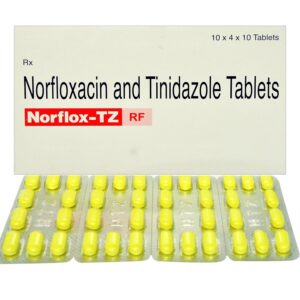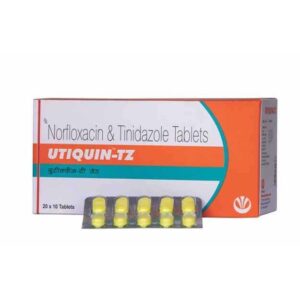TINIDAZOLE + NORFLOXACIN
Tinidazole: Tinidazole is an antibiotic medication that is primarily used to treat a variety of infections caused by certain parasites and bacteria. It belongs to the class of drugs known as nitroimidazole antibiotics.
The mechanism of action of Tinidazole involves interfering with the DNA synthesis of the microorganisms, thereby disrupting their ability to replicate and survive. This makes it effective against a wide range of pathogens, including protozoa and anaerobic bacteria.
Tinidazole is commonly prescribed for the treatment of infections such as giardiasis (intestinal infection caused by a parasite), trichomoniasis (a sexually transmitted infection caused by a parasite), and bacterial vaginosis (a vaginal infection caused by an imbalance of bacteria).
The dose of Tinidazole varies depending on the specific infection being treated. However, the usual recommended dose for adults is 2 grams, taken as a single dose. In some cases, the dose may be divided into smaller doses and taken over several days. It is important to follow the dosage instructions provided by your healthcare professional.
As with any medication, Tinidazole can cause side effects. Common side effects may include nausea, vomiting, diarrhea, stomach pain, headache, dizziness, or a metallic taste in the mouth. These side effects are usually mild and go away on their own. However, if they persist or become severe, it is important to consult a healthcare professional.
In rare cases, severe side effects may occur, such as allergic reactions, neurological symptoms (such as numbness or tingling), or changes in mood or behavior. If any of these serious side effects occur, it is important to seek immediate medical attention.
Tinidazole should be used with caution in individuals with a history of blood disorders or neurological disorders. It is also not recommended during pregnancy, as it may harm the developing fetus. It is important to inform your healthcare professional about any pre-existing medical conditions or medications you are taking before starting treatment with Tinidazole.
Overall, Tinidazole is an effective antibiotic medication used to treat infections caused by certain parasites and bacteria. It is important to use it as directed by a healthcare professional and to be aware of the potential side effects.
Norfloxacin: Norfloxacin is a prescription medication that belongs to the class of drugs known as fluoroquinolone antibiotics. It is mainly used to treat bacterial infections, particularly those affecting the urinary tract, prostate, and gastrointestinal tract.
The mechanism of action of norfloxacin involves inhibiting the bacterial DNA gyrase enzyme, which is responsible for the replication and repair of bacterial DNA. By interfering with this process, norfloxacin effectively prevents the bacteria from growing and spreading, ultimately clearing the infection.
The dosing of norfloxacin varies depending on the specific infection being treated. For urinary tract infections, the typical dose is 400 mg taken twice daily for 3 to 10 days. For gastrointestinal infections, the dose may range from 400 mg to 800 mg taken twice daily for 5 to 14 days.
While norfloxacin can effectively treat infections, it also has potential side effects. Common side effects include nausea, diarrhea, headache, abdominal pain, and dizziness. Less common but more serious side effects may occur, such as tendon rupture, increased sensitivity to sunlight, liver damage, and changes in blood sugar levels. It is important to inform your healthcare provider about any unusual symptoms experienced during norfloxacin treatment. Additionally, norfloxacin should be used with caution in individuals with a history of tendon disorders, as it may increase the risk of tendon rupture.


